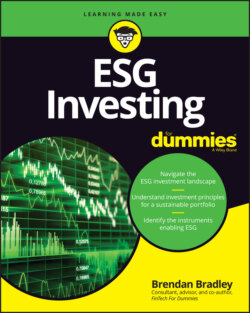Читать книгу ESG Investing For Dummies - Brendan Bradley - Страница 14
Defining the breadth of ESG
ОглавлениеUnlike common financial ratios, there aren’t a common set of ratios that neatly define what a good ‘E,’ ‘S,’ or ‘G’ score looks like. And whether you should aggregate the three siblings together or you should consider each one individually depends on your determination of what issues you believe are most relevant from an ESG perspective. Indeed, some of the factors may be more material to some stocks than others. For example, the environmental risks associated with a bank will be less material than those facing a mining company, while such risks may be counterbalanced by more concerns over governance with a bank. Also, to what degree should you be concerned, and what data or methodology will you use to gauge that concern? As you can see, ESG analysis brings an entirely new set of indicators that you need to consider, which can result in a complex analysis that isn’t reasonable for a layperson to calculate.
Of course, investment managers are offering to take all of that hassle away from you and present you with products that incorporate the myriad of factors in different ways. And as the investment world has moved toward passive investment, a number of these products will be index driven. To ensure that you’re familiar with these new products, and that they closely track the performance of established benchmarks, many of the new products will be ESG variations of traditional indexes, such as the S&P 500 or FTSE 100 indexes. So, they represent what you “know and love” with just a few exclusions here, some different weightings there, or a bias or tilt toward or away from given stocks. This should be easy for most investors to comprehend.
Then there is the version for sophisticated investors, including large asset owners such as pension funds and family offices, where that approach won’t pass the “smell test” given the level of fees they are paying for investment management. They expect a much more active management approach, with full consideration of the complex interdependencies that can be analyzed in this process. One way to visualize the approach that an asset manager could take is to consider a matrix, or a three-dimensional cube. An asset owner considers at least three dimensions to be important:
What are the key industry sectors that exhibit the greatest ESG risks or opportunities?
Which ESG execution strategy approach should you employ to benefit from this data?
What are the material ESG components that affect a company’s financial performance?
Welcome to the concept of the ESG Cube, which represents the intersections between these factors. Figure 1-2 illustrates the cube, using three axes: Industry Sectors on the X-axis, ESG Strategies on the Y-axis, and Material Indicators on the Z-axis.
© John Wiley & Sons, Inc.
FIGURE 1-2: ESG Cube with intersections between factors.
Each of these dimensions can be further categorized, as you find out in the following sections.
